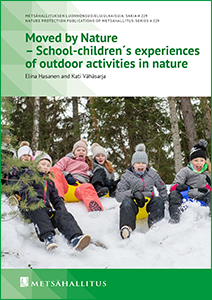Moved by Nature – School-children’s experiences of outdoor activities in nature
Physical activity in nature promotes well-being and growth among children in many ways but the activity has seen a worrying decline in recent decades. This study has generated knowledge on children’s experiences of different types of nature activities and on their relationship with outdoor activity.
The study examined the experiences of 4th and 5th graders (n=81) who participated in the interventions of the Moved by Nature project (2017-2019). The main data of the study comprised a survey, which was conducted three times among the same four school classes after nature activity days held during different seasons, and interviews of 11 children. The quantitative analysis of the survey data was combined with the qualitative content analysis of the interview data.
The experiences of the children during the nature activity days were very positive. The most meaningful experiences can be divided into three categories: 1) freedom, autonomy and adventure, 2) learning new things, challenging oneself and succeeding and 3) being together, friendship and community spirit. According to the results of the study, when organising nature activities, special attention should be paid to the balance between adult-led learning and self-initiated activity as well as to the meaningfulness of working together.
Approximately 90 percent of the children felt that outdoor activity in nature was important to them in their daily lives. Nature and activities in nature provided the children with sensory experiences, peace, time for recovery and withdrawal as well as opportunities for freedom and playfulness and thus acted as a counterweight to schoolwork, the urban environment and screen time. Almost half felt that the amount of nature activities at school was too low. The intervention strengthened the children’s relationship with outdoor activity in nature by familiarising them with nature and various nature activities, by providing personal experiences of the well-being effects of nature and by supporting the children in finding meanings that were significant to them. The most important outcome for the children was the strengthening of friendships and the feeling of togetherness in the class. A significant observation of the study was that children felt that lack of time was preventing them from partaking in outdoor activities in nature in their daily lives.
The results provide new information on the meanings and experienced effects of outdoor activities in nature as well as their role in the everyday lives of children. The study also provides justification for increasing the amount of nature activities at schools as well as for promoting outdoor activities in nature that family members can enjoy together. The results are useful when developing organised outdoor activity and services in nature aimed primarily at children and youths and when advancing nature activities for school classes.
